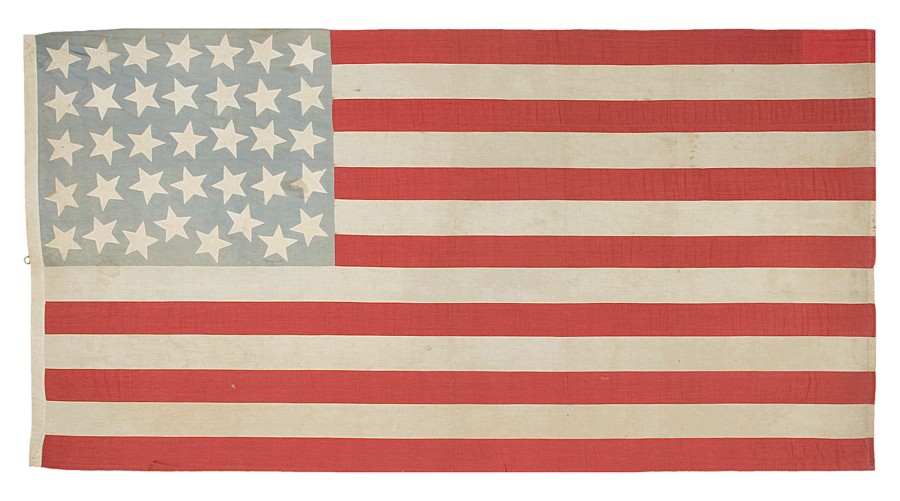
| |
36 STARS, 1864-67, CIVIL WAR ERA, WHIMSICAL STAR PLACEMENT ON A FADED BLUE CANTON |
|
| Available: |
Sold |
| Frame Size (H x L): |
|
| Flag Size (H x L): |
52" x 101" |
|
| Description....: |
|
36 STARS ON A CANTON THAT HAS ATTRACTIVELY FADED TO A LIGHT SKY BLUE, 1864-67, CIVIL WAR ERA, NEVADA STATEHOOD:
36 star American national flag of the Civil War era, with some great graphic qualities. These include its rather large stars that point in random directions on their vertical axis. Near the top, the stars are arranged in rows, but as they near the bottom, the linear formation deteriorates into a whimsical, random scatter that almost looks as if the bottom just fell out from underneath it and the stars were caught in a photograph, just before they all tumbled out into the stripes below. Note how the canton has faded to a light sky blue coloration that is both unusual and endearingly beautiful, lending visual evidence to the age of this mid-19th century textile.
The 36th state, Nevada, entered the Union during the Civil War on October 31st, 1864. The last Confederate general surrendered on May 26th, 1865. The 36 star flag became official on July 4th of that year, but flag-makers would have generally begun adding a 36th star to their flags in 1864, sometimes even well before the addition of the new state occurred, as evidenced by some surviving, dated examples.
Lincoln pushed Nevada through just 8 days before the November election. Nevada's wealth in silver was attractive to a nation struggling with the debts of war and increased support for the Republican ticket. The 36 star flag was replaced by the 37 star flag in 1867, with the addition of Nebraska.
Construction: The flag is made entirely of cotton. The stars are single-appliqued. This means that they were applied to one side of the canton, then the blue fabric was cut from behind each star, folded over, and under-hemmed, so that one star could be viewed on both sides of the flag. I always find single-appliqued stars more interesting because they are evidence of a far more difficult level of seam-work. Note how the two visible rows of stitching are less than 1/8" apart. Both rows were executed with treadle stitching, which is a very rare trait for a flag made in this period. The sewing machine had been mass-marketed by Singer in 1855 and by the outbreak of the Civil War, just 6 years later, was used in the piecing of most stripes on American flags. But seamstresses still found it far easier to hand-sew stars, not yet having mastered the skill of turning the fabric to applique them to the canton while pumping the treadle mechanism. Applique work is a far more skilled task than piece work for any seamstress. The art of single-applique was even more difficult, and the level of difficulty was further compounded by the attempt to use a sewing machine to complete it. As time passed, so did skill with treadle sewing machines, but treadle-appliqued stars aren't seen with any regularity on American flags until the 1890-1895 period.
The stripes of the flag and the hoist binding are also made of cotton and joined with treadle stitching. Three metal rings were hand-sewn to the binding using small tabs made of white cotton, so that the flag could be more easily hoisted.
Mounting: The flag has not yet been mounted. Please inquire about conservation and framing options.
Condition: The blue canton has experienced significant fading. There is minor fading of the red stripes, accompanied by minor foxing, staining, and fraying throughout. |
|
|
|
| Collector Level: |
Intermediate-Level Collectors and Special Gifts |
|
| Flag Type: |
Sewn flag |
|
| Star Count: |
36 |
|
| Earliest Date of Origin: |
1864 |
|
| Latest Date of Origin: |
1867 |
|
| State/Affiliation: |
Nevada |
|
| War Association: |
1861-1865 Civil War |
|
| Price: |
SOLD |
|
| |
Views: 4216 |
|
|
|

